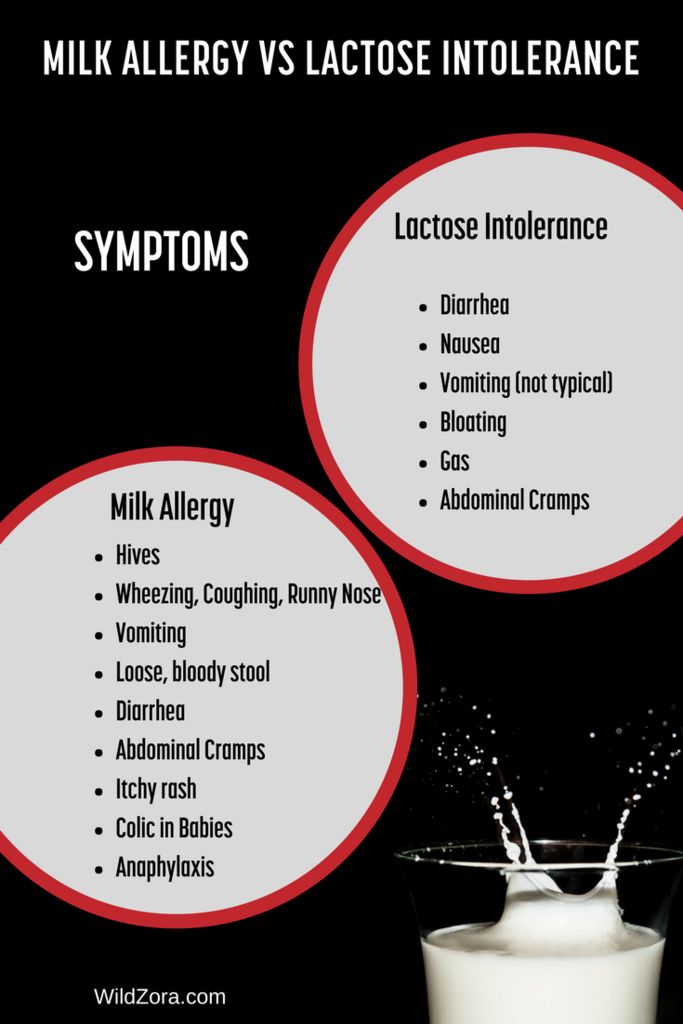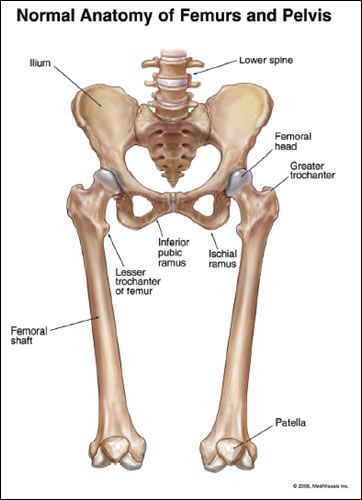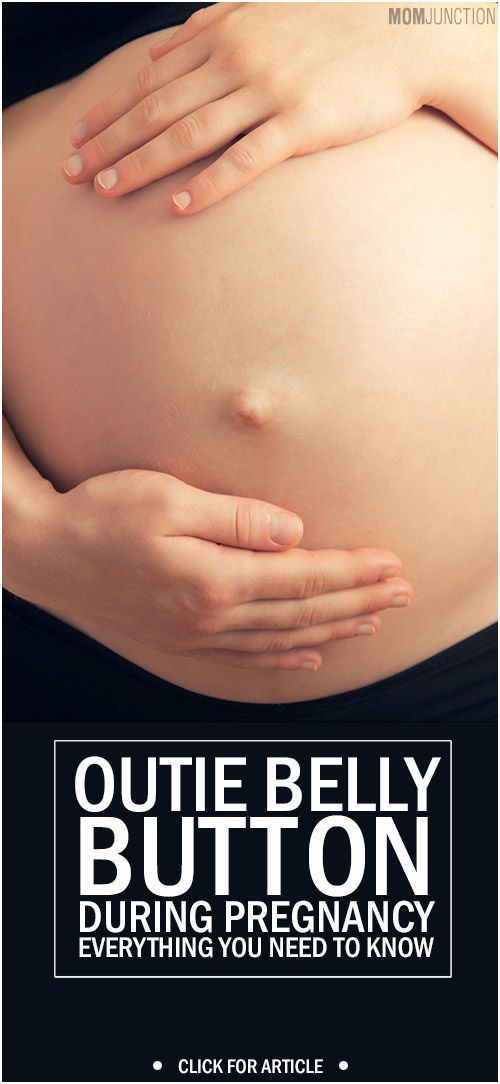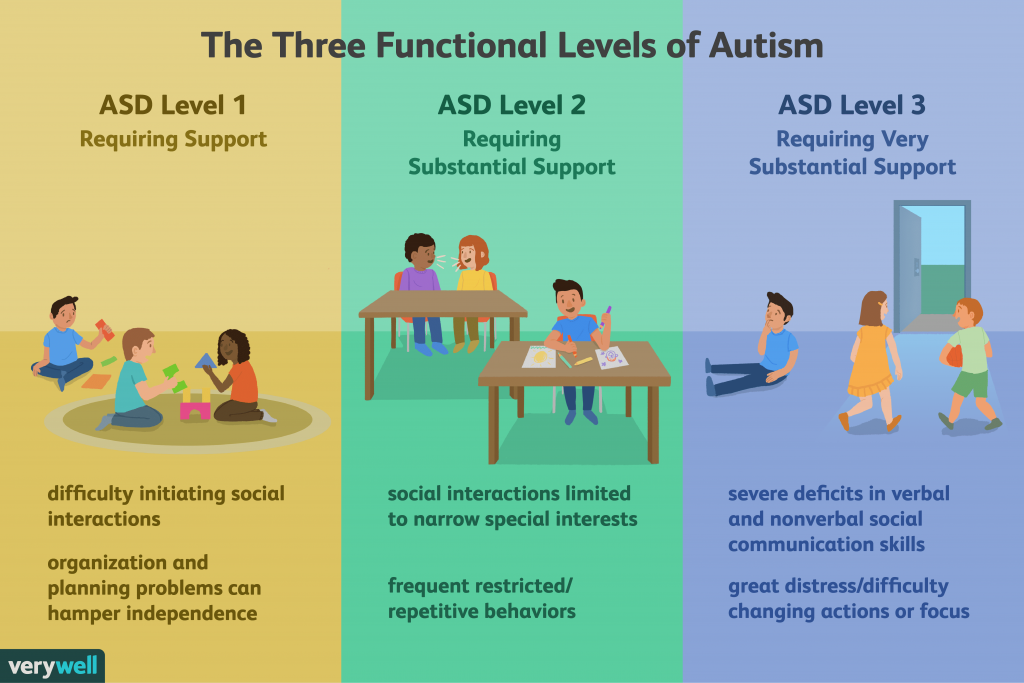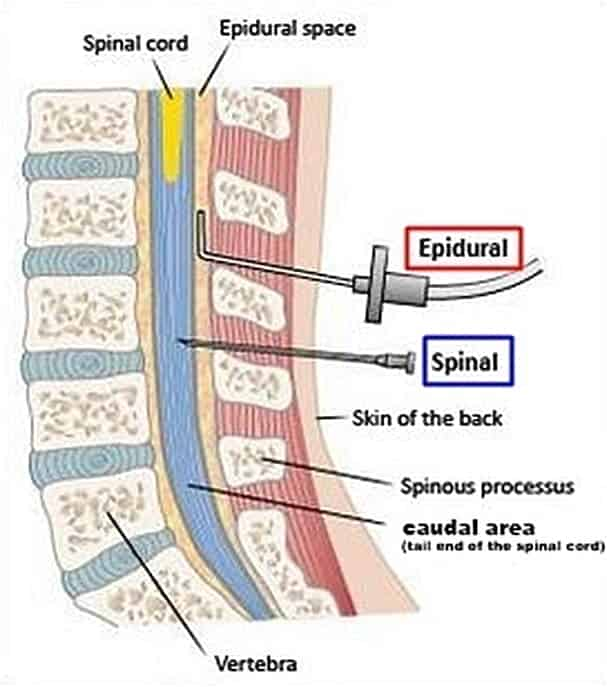Six month developmental milestones
Your baby's developmental milestones at 6 months
Explainer
Everything you need to know about your growing 6-month-old.
UNICEF
At 6 months, your baby will start using sounds to express emotion. She/he may mimic sounds she/he hears, like "ma,” “da,” “ah,” “oh" and even "no!" Your little one will begin to recognize familiar faces, reach and grasp for toys and will soon be crawling — start preparing your home (and yourself) for a mobile child!
Get ready by removing any sharp, breakable or electric objects from the child’s reach, locking closets with dangerous liquids or supplies (or putting them in a safe place far out of your child’s reach), and closing windows to ensure your child’s safety.
| Social and emotional |
| Language and communication |
| Brain development |
| Movement and physical development |
| Food and nutrition |
| Things to look out for |
| Tips and resources |
| < Back to Parenting Milestones |
Social and emotional milestones at 6 months
Some of the ways you’ll see your little one learning to connect with the people around him at 6 months.
- Is usually happy and responds to the emotions of others.
- Starting to differentiate between familiar faces and strangers.
- Enjoys playing with you and others.
- Has fun looking at himself in a mirror.
Tips for parents
- Talk to your baby about what is going on around him in a sweet tone.
- Include a child-friendly or plastic mirror with his toys so he can watch his movements.
- Start playing more body games like peek-a-boo.
Language and communication milestones at 6 months
How your baby is expressing her needs.
- Will recognize and respond to her name.
- Puts vowel sounds together and likes taking turns saying them with you. She is starting to make some consonant sounds, too.
- Will respond to noises by making sounds.
- Is making sounds to show positive and negative emotions.
Tips for parents
- Engage in playful conversations with your baby: Create a serve-and-return interaction by repeating back to her the sounds she makes.
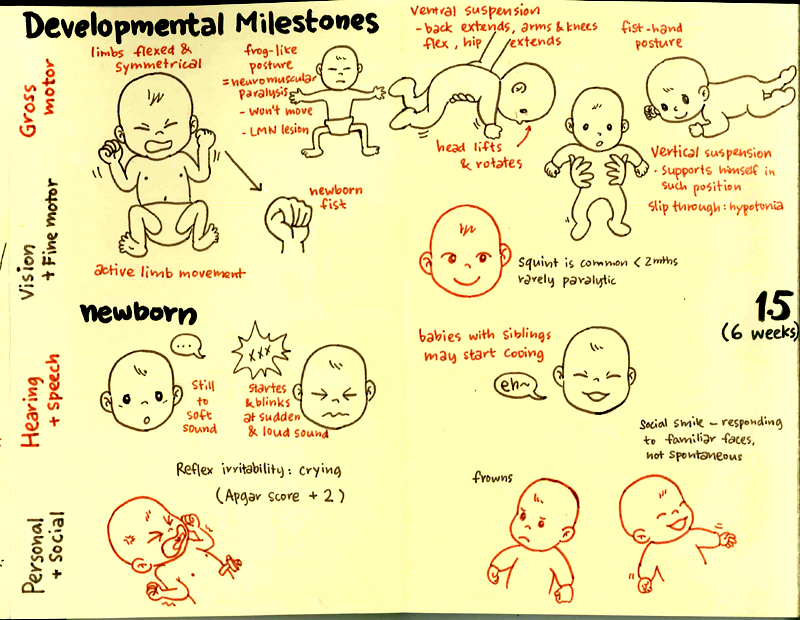
- Familiarize your baby with her name by using it frequently.
Brain development milestones at 6 months
Your child’s brain is growing!
- He is curious: He looks at objects nearby and tries to grab ones that are out of reach.
- He passes things from one hand to the other and brings his hands to his mouth.
Tips for parents
- Provide your baby with toys that are easy to pick up with one hand.
- Have conversations with your baby about different objects he is putting into his mouth.
Movement and physical development milestones at 6 months
How she’ll move through her environment.
- Is starting to be able to sit without a support.
- Is rolling over in both directions.
- Will push down on her legs when her feet are on a hard surface.
- Rocks back and forth.
Tips for parents
- Leave her favourite toys nearby so she can reach them by rolling over.

Food and nutrition milestones at 6 months
What mealtimes look like at 6 months.
- Is showing an interest in food and opens his mouth when spoon fed.
- Is moving food from the front to the back of his mouth when he chews.
- Is starting to eat cereals and single-ingredient pureed foods like carrots, sweet potato and pears.
Tips for parents
- At 6 months, your baby needs more than breastmilk alone. Start giving him just 2 or 3 spoonfuls of soft food four times a day.
Things to look out for
While all babies develop differently, you should speak to your paediatrician immediately if your 6-month-old:
- Doesn’t show affection to parents or caregivers.
- Won’t respond to nearby sounds.
- Doesn’t laugh.
- Has a hard time getting things into her mouth.
- Doesn’t make vowel sounds.
- Seems too floppy or too stiff.
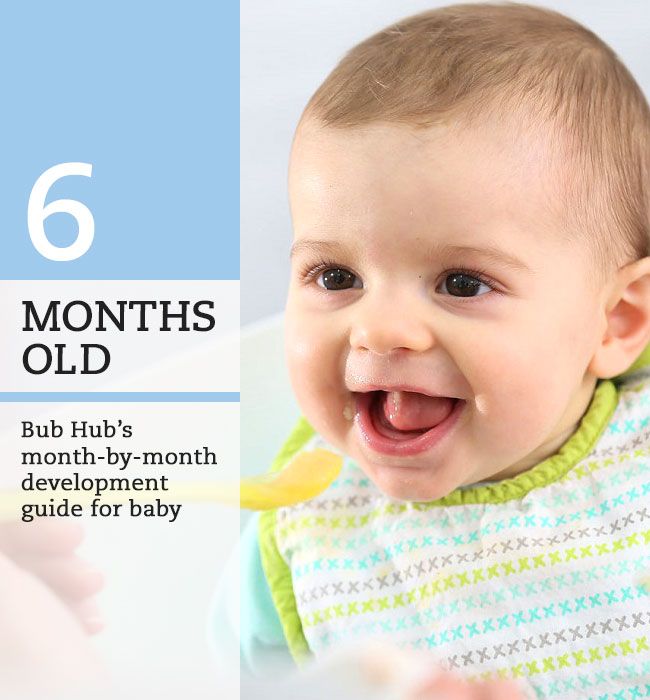
- Can’t roll over in either direction.
- Doesn’t attempt to grab objects nearby.
True or False?
Loading...
Explore age groups
2 Months | 4 Months | 6 Months | 9 Months | 1 Year | 18 Months | 2 Years
< Back to Parenting Milestones
6-month-old baby: Development, Milestones & Growth
- Community
- Getting Pregnant
- Pregnancy
- Baby names
- Baby
- Toddler
- Child
- Health
- Family
- Courses
- Registry Builder
- Baby Products
Advertisement
Your baby is halfway through the first year! You may be amazed by your 6-month-old's new tricks: rolling over both ways, bouncing when held, sitting without help – maybe even lunging and trying to crawl. You'll notice your baby working on smaller movements too, such as picking up objects and moving them from hand to hand – a skill that comes in handy for playing and eating.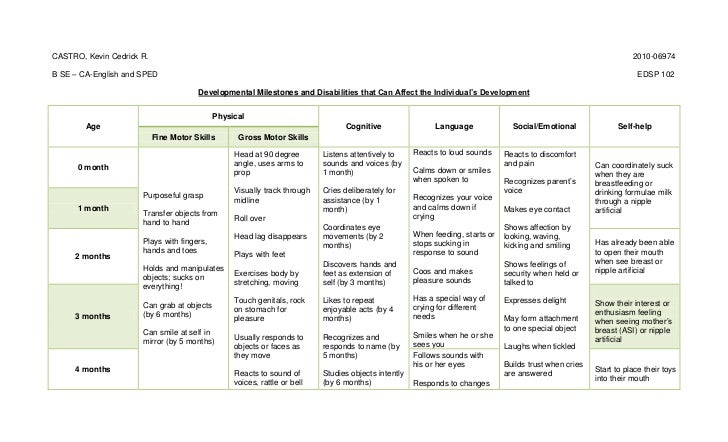 Your baby is probably ready to try solid foods if they haven't already, so get ready for messy fun.
Your baby is probably ready to try solid foods if they haven't already, so get ready for messy fun.
Photo credit: iStock.com / Gerber86
It's your baby's half-birthday! It's a good time to celebrate and reflect on the remarkable changes your 6-month-old has gone through. No longer a helpless, tiny newborn, your active baby is ready to explore the world. Here's more of what's in store for your baby at 6 months old.
Your baby's development
Your baby is fully engaged with the world now. They smile, laugh, and have babbling "conversations" with you. And your baby is on the move – by this month or the next, your little one will most likely roll onto their tummy and back again, sit without help, and support their weight with their legs well enough to bounce when you hold them. Your baby may use a raking grasp to pull objects closer, and can hold toys and move them from one hand to another. Your curious 6-month-old may be grabbing for dangly earrings and necklaces – and watch out for your glasses, because your baby may snatch them off your face!
6-month-old milestones
Here are some of the milestones that your 6-month-old may reach:
- Recognizing people.
 By 6 months old, your baby will know familiar faces and people and recognize when someone is a stranger. They'll also enjoy looking at their own face in the mirror, and may love the mirrors on their toys and play mat.
By 6 months old, your baby will know familiar faces and people and recognize when someone is a stranger. They'll also enjoy looking at their own face in the mirror, and may love the mirrors on their toys and play mat. - Playing. From peekaboo to patty-cake, your 6-month-old probably loves playing. And of course, playtime isn't just about fun and games; your baby is working on new skills and learning how to navigate the world around them. So, keep the good times rolling!
- Reacting to your emotions. Your baby loves you, and when you're unhappy or stressed, your baby can sense it and may even mirror your emotions. If you're crying, your little one may burst out in howls of their own.
- Communicating with you. Your baby may begin babbling back to you when you talk to them. They'll start stringing consonants and vowels together, saying things such as "baba," and pausing so you can have a "conversation" with them. Encourage your baby's attempts at speech by talking back, reading to your baby, and listening to them.
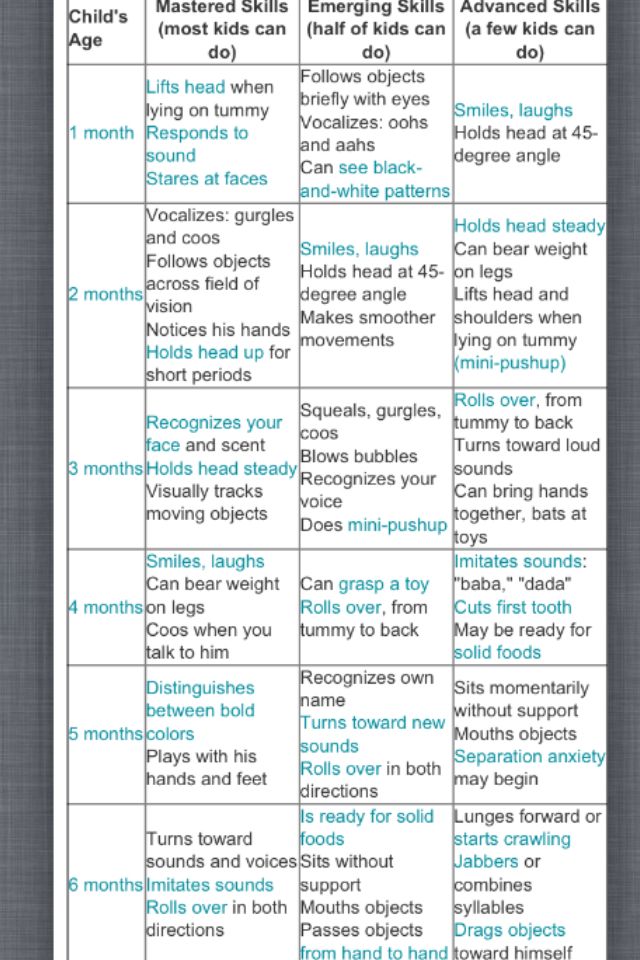 Also, your baby may know their name, and might even respond to it.
Also, your baby may know their name, and might even respond to it. - Exploring. Your 6-month-old will be curious about the world: looking around, reaching for objects, and trying to put everything (and we do mean everything) in their mouths. Make sure choking hazards – such as batteries, balloons, small magnets, coins, and older siblings' toys – are well out of reach.
- Hand coordination. Your baby's hand coordination is getting more advanced, and they can do things like pass an object from one hand to another.
- Rolling over. Your baby probably started rolling from their stomach to their back and then mastered the more difficult task of rolling from their back to their stomach. Once your little one is rolling both ways, watch out! You'll need to be extra vigilant anytime your baby is on a high surface (like a changing table) or even the floor, because they may roll over to a dangerous area.
- Trying to crawl.
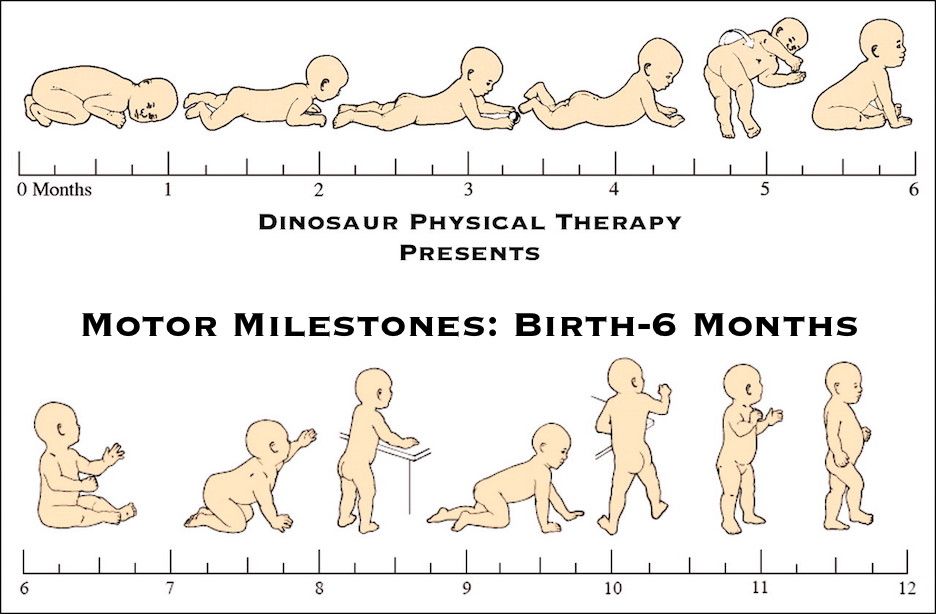 Some babies will start working on the motions needed for crawling this month. You may notice your baby getting up on all fours and rocking back and forth. A few babies will start crawling at this age, but most won't crawl until they're closer to 9 or 10 months old.
Some babies will start working on the motions needed for crawling this month. You may notice your baby getting up on all fours and rocking back and forth. A few babies will start crawling at this age, but most won't crawl until they're closer to 9 or 10 months old. - Sitting up. Your baby may be shaky at first and require some extra support – like pillows – to sit up. (Make sure to supervise your budding sitter, because they will topple over!) In the next month or so, your baby will develop the core and neck muscles necessary to sit up independently with good head control. This will open up a whole new world: Your baby will have a better view and be able to use a highchair, cruise in a jogging stroller, and ride in a backpack carrier.
- Bouncing. Although your baby isn't ready to stand on their own, they can support their weight with their legs if you hold them, and may enjoy bouncing up and down. Many 6-month-olds love using a baby bouncer.
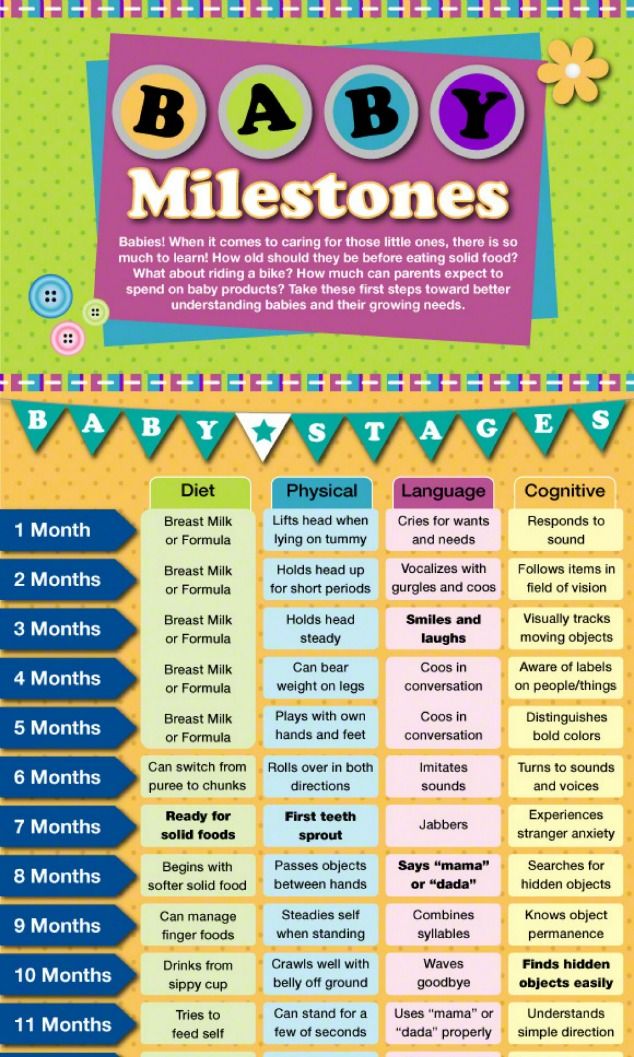
Although babies follow fairly predictable patterns of development, all babies are different. It's a good idea to be aware of milestones and tell your baby's care provider if you have any concerns about developmental delay. But keep in mind that some babies just need a bit more time to learn skills and hit milestones.
6-month-old weight and length
How much should a 6-month-old weigh? At this age, babies can vary quite a bit. Here are some averages:
Baby boys
Average weight for a 6-month-old: 17 pounds 7 ounces
Average length for a 6-month-old: 26 1/2 inches
Baby girls
Average weight for a 6-month-old: 16 pounds 2 ounces
Advertisement | page continues below
Average length for a 6-month-old: 26 inches
Your baby has been putting on weight at a pretty fast pace for the past 6 months. But from 6 to 9 months, your baby's growth rate will naturally slow down. That's partly because your active baby is expending more energy, but also just how we're built.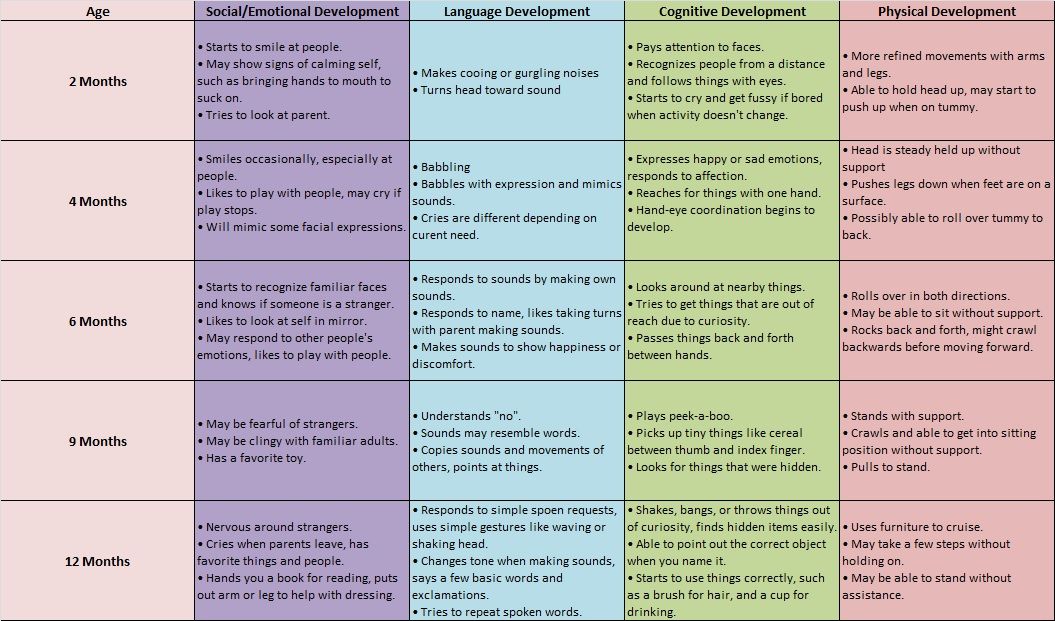 If you have any concerns about your baby's weight or growth, be sure to talk to their provider.
If you have any concerns about your baby's weight or growth, be sure to talk to their provider.
6-month-old feeding
If you haven't yet, it may be time for a major feeding milestone: Introducing baby food! Experts recommend starting solids when babies are between 4 and 6 months old and show signs of readiness, like:
- being able to sit upright in a high chair or infant feeding seat
- good head control
- opening their mouth when food is offered
- bringing objects to their mouth
- being able to move food to the back of their mouth and swallow it, rather than pushing it back out with their tongue
However, you don't have to break out the baby food just because your baby is 6 months old. Some babies may be ready for solid foods right at 6 months or before; others may need a little bit more time.
Once you decide it's time, you can start by introducing pureed fruits, vegetables, or meat. Although it used to be standard for parents to give babies infant cereal as their first food, it's not necessary. Good first foods include pureed sweet potatoes, squash, applesauce, bananas, peaches, and pears.
Good first foods include pureed sweet potatoes, squash, applesauce, bananas, peaches, and pears.
Here are more solid feeding tips from the American Academy of Pediatrics (AAP):
- start with half a spoonful or less of food
- don't be surprised if your baby is confused or rejects solid food at first
- offer breast milk or formula before and after solids so your baby doesn't get hungry and frustrated
- if your baby cries or turns away, don't try to make your baby eat; instead, wait and try again
- foods should be soft or pureed to prevent choking
- introduce one single-ingredient food at a time, and wait 3 to 5 days before introducing another food so you can watch for any allergic reactions
- include foods that provide iron or zinc, such as pureed meat or iron-fortified cereals
You don't need to wait to introduce allergenic foods such as eggs, soy, peanut products, or fish. (As long as they're safe foods for babies to eat.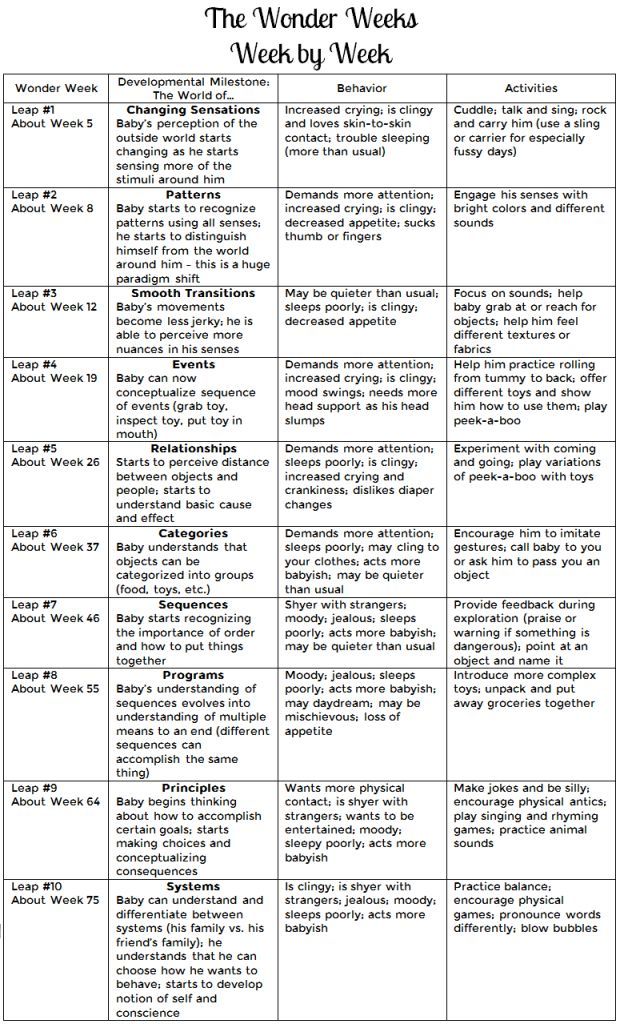 ) But testing for peanut allergy is recommended for babies with severe eczema and/or an egg allergy.
) But testing for peanut allergy is recommended for babies with severe eczema and/or an egg allergy.
If your baby rejects solid foods for now, don't worry. Just continue to offer them, and keep in mind that it can take several tries before your baby accepts a new food. Start with one daily feeding, and see our age-by-age baby feeding guide to find out what to expect next.
Until they're 1 year old, your baby will still rely on breast milk or formula to meet the majority of their nutritional needs. Expect your 6-month-old to have between 28 and 32 ounces of breast milk or formula per day. This works out to about 5 to 6 bottles or nursing sessions a day.
Of course, your breastfed baby may want to nurse for comfort, too, and that's okay. All this growth and development can be tough and sometimes, they might just want to be close to you.
One more note about feeding: As your baby starts to eat solids, their poop may become firmer, change color, and smell much worse. This is normal.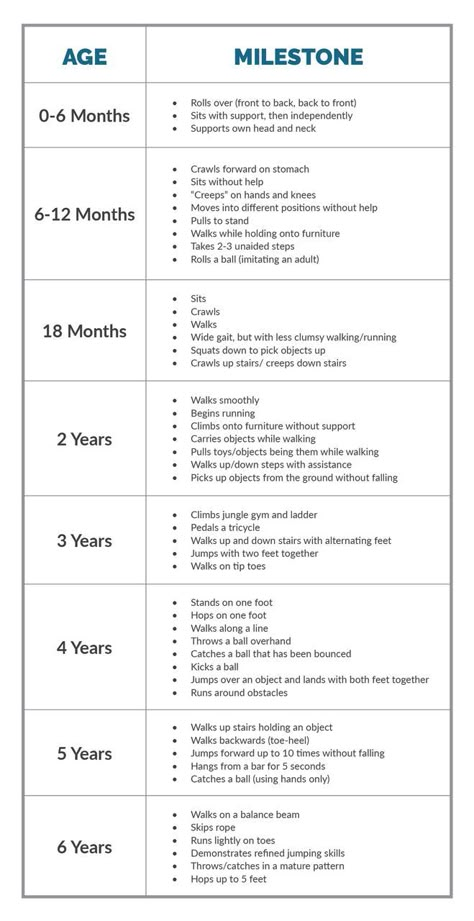 But if your baby's poop is extremely loose, watery, or full of mucus, talk to your baby's provider.
But if your baby's poop is extremely loose, watery, or full of mucus, talk to your baby's provider.
6-month-old sleep
How much should a 6-month-old sleep? Estimates vary a bit, but in general your baby will need anywhere from 12 to 16 hours of sleep every 24 hours, including nighttime sleep and naps. This may look something like 14 hours total, with 10 hours of nighttime sleep and 4 hours of daytime sleep.
Some 6-month-olds may start resisting naps and nighttime sleep because they're so excited about all the skills they're building. Babies this age need their sleep as much as ever, but may not want to go to sleep and miss out on the action. If your baby is getting into some not-so-great sleep habits – and maybe even experiencing a sleep regression – here are some tips on helping your baby sleep well, and sample baby sleep schedules you can look at for guidance.
Most babies at this age have settled into a more predictable sleep schedule, sleeping through the night and taking 2 or 3 naps per day. For example, your baby might sleep through the night, then take both a morning and afternoon nap.
For example, your baby might sleep through the night, then take both a morning and afternoon nap.
However, all babies are different, and your baby may still wake up to eat at night. If you enjoy nursing or giving a bottle to your baby at night, there's no reason to stop – your baby will eventually quit on their own. On the other hand, if you find yourself feeling grumpy and exhausted – and your baby's physically ready for the change – look into night weaning.
Your baby's health
It's time for another well-baby visit! Regular doctor visits are important to ensure that your little one is growing well. The 6-month visit is also a chance for you to discuss any concerns you have and address any challenges in your baby's sleep or feeding. Here's what you can expect at the 6-month checkup:
- A medical assistant or nurse will take all of your baby's physical measurements, including weight, length, and head circumference. Those measurements will be plotted on a growth chart to track your baby's growth over time.
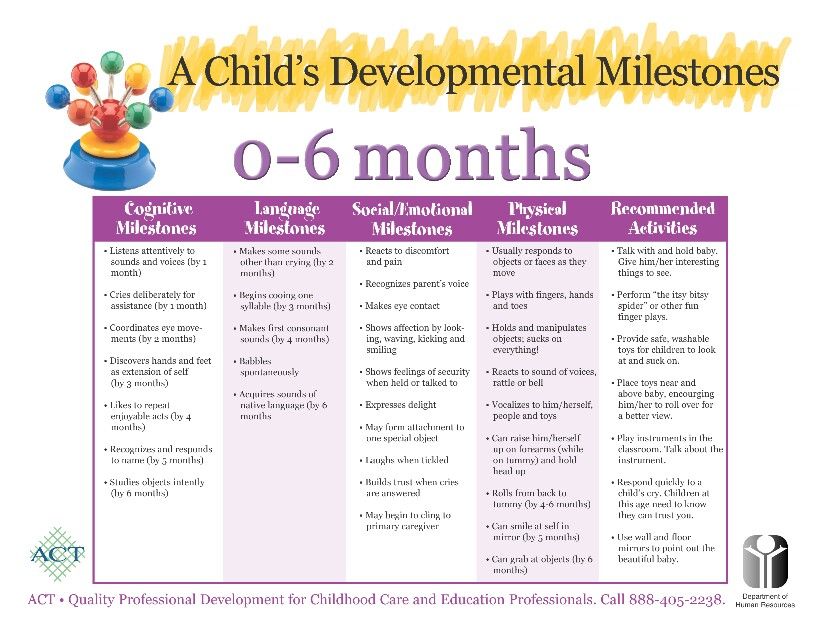 Remember, no two babies develop the same way.
Remember, no two babies develop the same way. - Your baby's doctor will address any concerns about sleeping, feeding, and behavior and ask about your baby's sleeping and eating habits. They'll also review developmental milestones and check that your baby is developing appropriately.
- The doctor will do a complete physical and check your baby from head to toe, including the diaper area.
- The doctor will ensure that you're following recommended steps to keep your baby healthy, including baby-proofing your home, using a car seat safely, practicing safe sleep habits, and keeping up on vaccinations.
Your baby is also due for several vaccines at this visit. These are all the next dose in the series of vaccines your baby likely had at the 2-month and 4-month checkup. Here's what's recommended:
- Pneumococcal vaccine. Prevents against pneumococcal infections, which can occur in children under the age of 5.
- DTaP vaccine. The DTaP vaccine protects against diphtheria, tetanus, and pertussis (whooping cough).
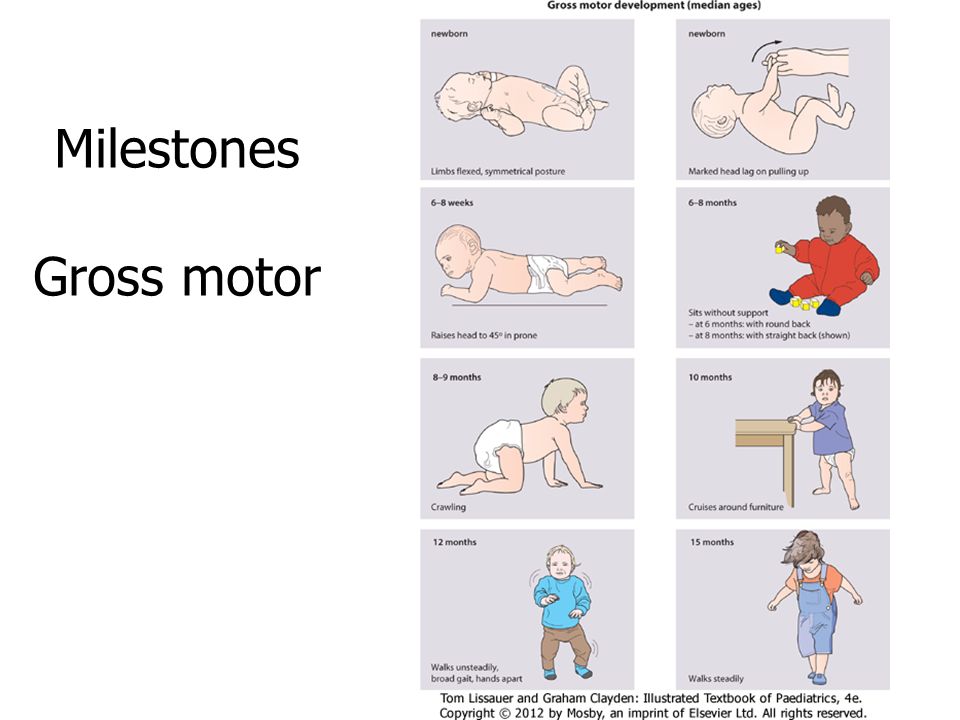 Whooping cough can be especially dangerous in babies.
Whooping cough can be especially dangerous in babies. - Hib vaccine. The Hib vaccine protects against a type of bacterial infection that can cause serious illnesses in babies, such as meningitis and pneumonia.
- Polio vaccine. Thanks to this vaccine, polio is almost eradicated in the U.S. Prior to widespread immunization, polio (which is caused by a virus) caused paralysis in about 1 percent of people.
- Rotavirus vaccine. Rotavirus is the leading cause of diarrhea in babies worldwide. Diarrhea in a baby is a miserable experience you'll want to avoid if you can. Plus, this vaccine is given orally, so no pokes necessary.
Your baby is also eligible for the flu vaccine this month for the first time. If your well-baby visit is scheduled anytime during flu season – October through March – the doctor may recommend the flu vaccine for your baby. The flu vaccine protects children from influenza viruses that can cause serious illness and even death. Children ages 2 and younger who get the flu are the most likely to have serious complications.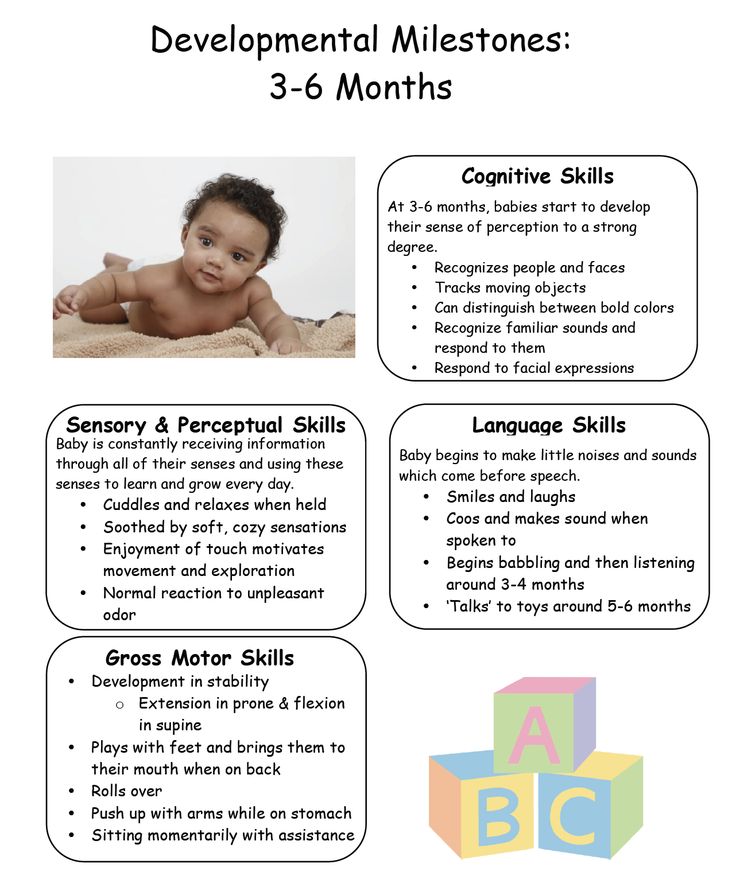
Your 6-month-old baby: Week by week
Want to learn more about what's happening with your baby this month? Get more details on your 6-month-old's weekly development:
- Your 6-month-old: Week 1
- Your 6-month-old: Week 2
- Your 6-month-old: Week 3
- Your 6-month-old: Week 4
Chaunie Brusie
Chaunie Brusie is a health and parenting writer, and a former labor and delivery nurse. Her work has appeared in publications ranging from Glamour to The New York Times to Parents magazine. Brusie lives with her husband and five young kids on a small farm in Michigan that’s in the middle of an actual hayfield.
Baby milestones: 1-6 months
What to expect from your baby in the first six months of life.
- CHILD DEVELOPMENT: Some children may reach developmental milestones more quickly and others a little more slowly.
In the first year of life, your newborn baby will grow rapidly, gain weight and height, and reach new milestones every month.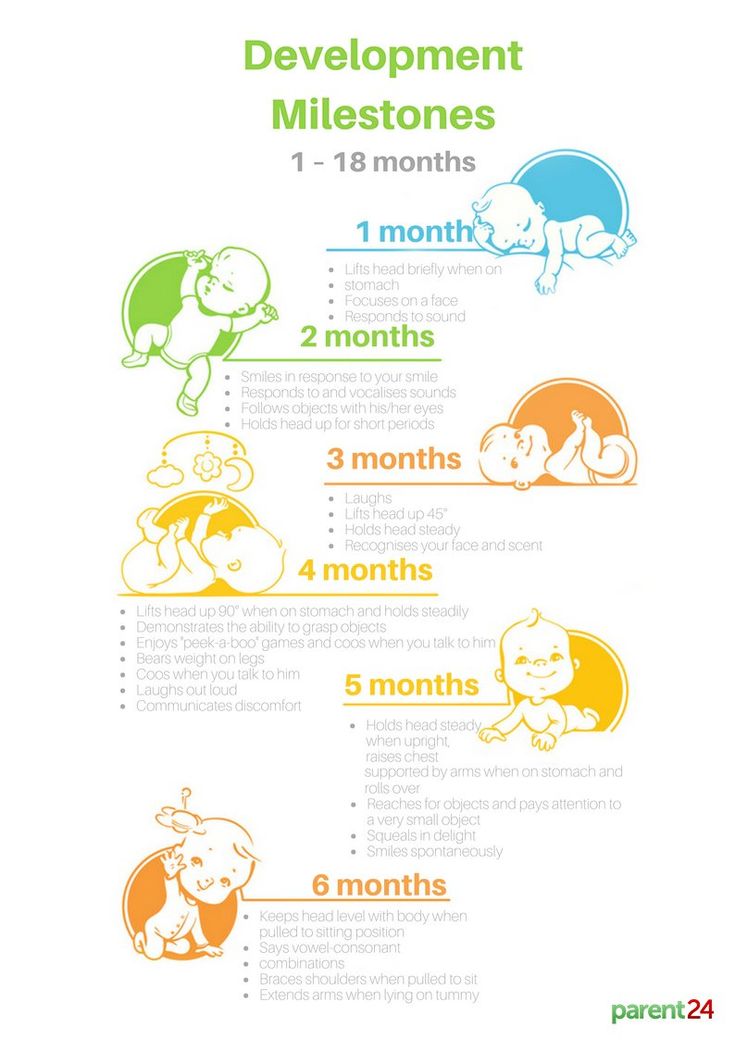 The transformation from a sleepy newborn to an active baby will be wonderful and will happen right before your eyes.
The transformation from a sleepy newborn to an active baby will be wonderful and will happen right before your eyes.
Your newborn baby will spend the first few weeks after birth sleeping 24/7, waking up only to feed or change a diaper. Yawning, sneezing, hiccups, stretching are some of the actions your newborn will exhibit. This is the first stage in the development of the child, which will not last long.
All babies develop at different rates
Although all babies have the same developmental stages, each baby will have their own rate of growth and development due to various hereditary and environmental factors. Don't worry if your child develops more slowly. Remember: the brilliant scientist Einstein in his early years was considered a very boring and retarded student.
The main stages of child development in the first six months: month by month
- 1 month:
In the first month, children sleep a lot and stay awake little. They will look at you when you talk to them and may open and close their mouths as if they were talking to you.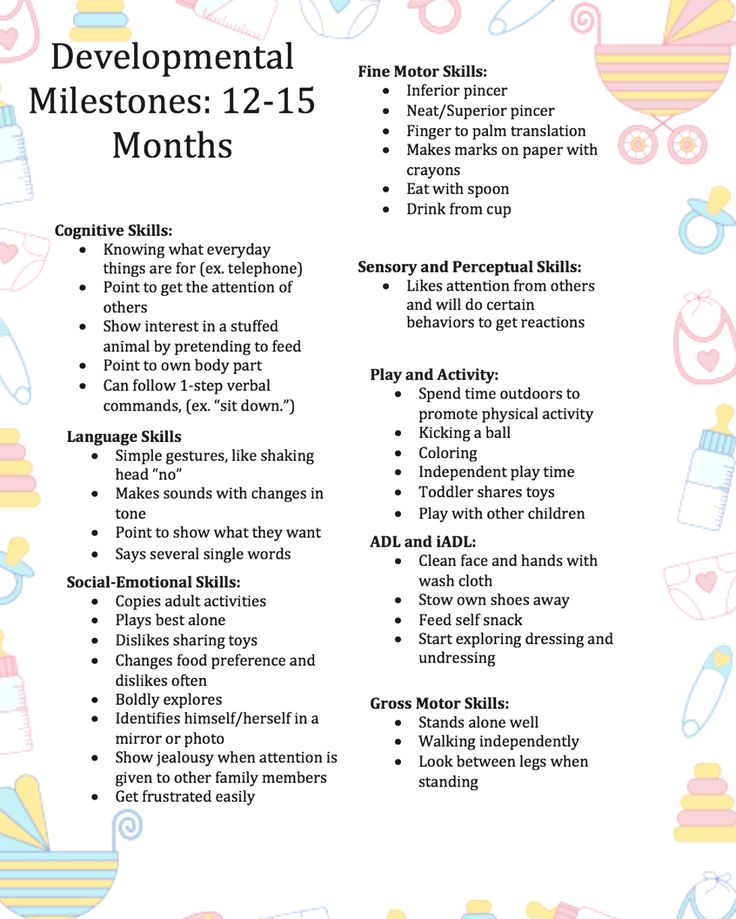 They can follow moving objects with their eyes and see colorful toys hanging in front of them. At this stage in the development of the baby, they begin to smile.
They can follow moving objects with their eyes and see colorful toys hanging in front of them. At this stage in the development of the baby, they begin to smile. - 2 months:
Babies will smile if you talk to them or stimulate them in any way. This is called a social smile. At this stage, they will also begin to coo and be able to move their head and follow a moving person or object almost 180 degrees. They will be able to hold their head up, but it will wobble periodically as they don't have full head control. - 3 months:
Babies have better head control and can lift their heads quite high when laid on their stomachs. At this stage of development, babies become more attentive and can observe the movements of their hands with curiosity. Not only will they smile when you talk to them, they may also respond with a squeal of delight. They will be able to hold a rattle or a toy in their hands. - 4 months:
Babies can now keep their heads up at all times.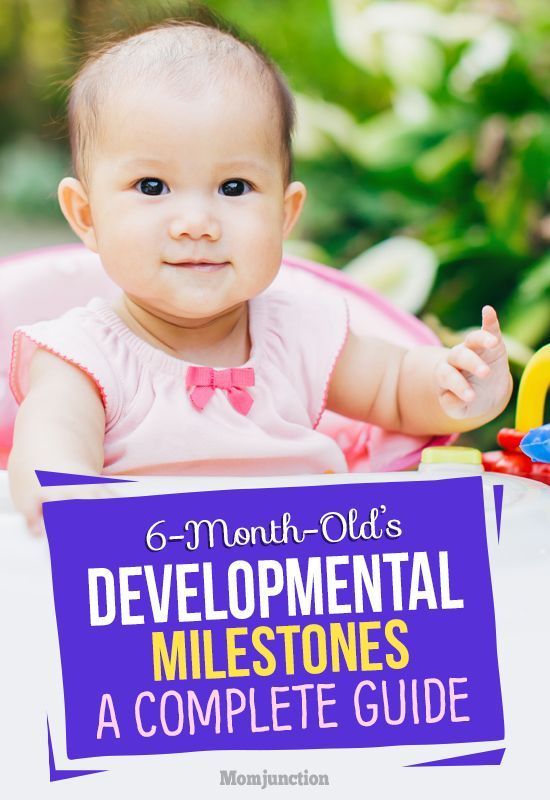 If you put them on your stomach, they will be able to keep their head and chest above the surface. They love to play with their hands. They will also enjoy shaking the rattle, enjoying its sound. They are curious and constantly looking around. They are fun to play with and can laugh out loud when tickled.
If you put them on your stomach, they will be able to keep their head and chest above the surface. They love to play with their hands. They will also enjoy shaking the rattle, enjoying its sound. They are curious and constantly looking around. They are fun to play with and can laugh out loud when tickled. - 5 months:
By now, babies have complete head control and can grasp toys firmly. They enjoy playing with toys, crumpling paper and splashing water in the bathtub. They smile a lot when you talk to them and also smile at their own image in the mirror. - 6 months:
Babies can roll over on their side in the middle of their first year of life. Their legs are stronger and will be able to support their weight if you put them on. At this stage of the baby's development, they are more playful and will gladly hold their feet and suck their toes. They can blow bubbles and playfully stick out their tongue. They will enjoy playing hide and seek with you, but they can become shy if a stranger joins the game.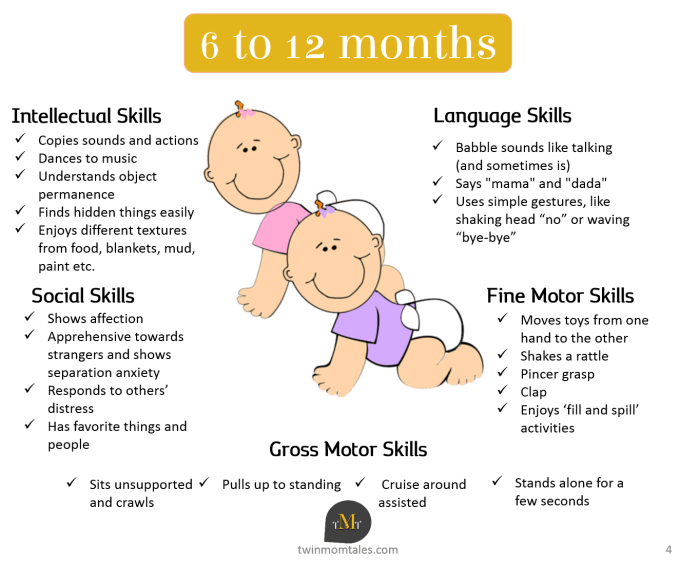 They may begin to show anxiety and may also express likes and dislikes for certain foods. Your baby may start making sounds such as "yes, ba, ka."
They may begin to show anxiety and may also express likes and dislikes for certain foods. Your baby may start making sounds such as "yes, ba, ka."
Read on to learn about the milestones in your baby's development over the next 6 months.
Child Development Calendar from the Health of the Nation
The Child Development Calendar from the Health of the Nation medical center is a convenient system that tells parents by months how the baby is developing.
Child development by months
Newborn
How does the baby behave in the first weeks of life? Should I be worried if he sleeps 18 hours a day? What you need to know about the features of feeding the crumbs, and what recommendations for care should be followed?
Read more
1 month
What happens to a child at the age of one month, how his behavior changes.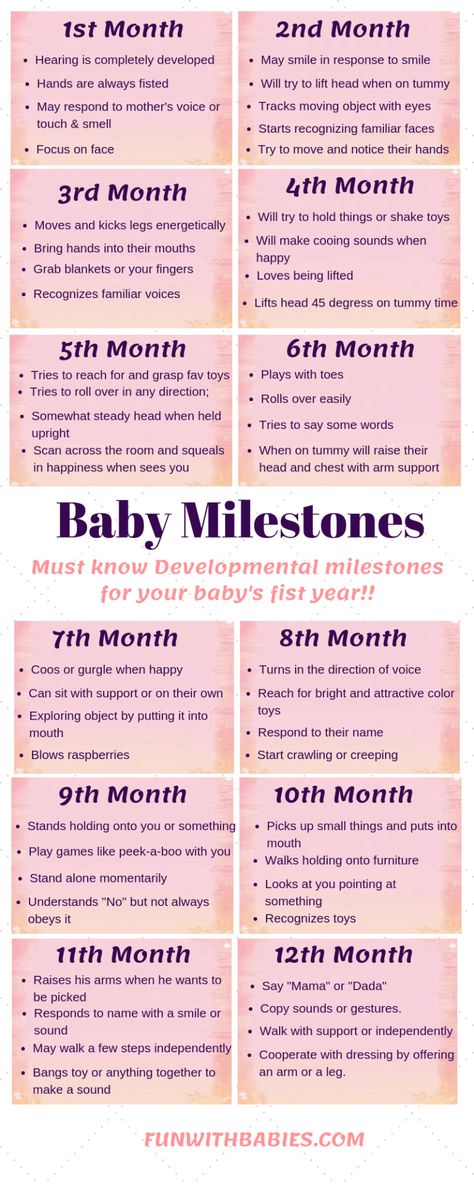 Features of development and the emergence of new actions. What you need to know about nutrition, daily care. Planned visits to doctors and testing.
Features of development and the emergence of new actions. What you need to know about nutrition, daily care. Planned visits to doctors and testing.
Read more
2 months
What happens in the life of a child at the age of 2 months? What behaviors should be taken into account? The appearance of the first emotions of the baby, the development of the vocal apparatus.
Read more
3 months
What discoveries do parents expect when their child is 3 months old? The emergence of new skills, the first conscious manifestation of emotions and desires. What you need to know about the features of feeding?
Read more
4 months
What happens to a 4 month old baby? The first serious games and interaction with the outside world.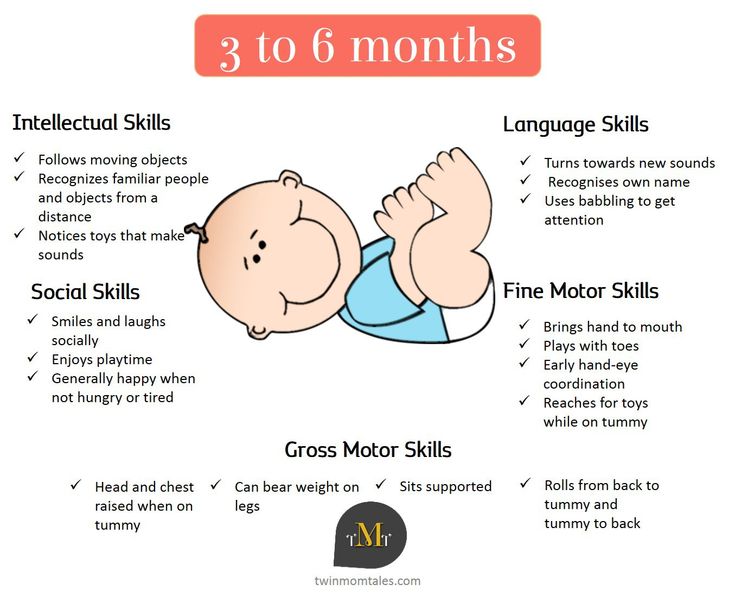 What you need to know about the features of feeding, and what recommendations for care should be followed?
What you need to know about the features of feeding, and what recommendations for care should be followed?
Read more
5 months
Transition period from horizontal position. What you need to know about the features of feeding crumbs? What should parents of a five-month-old baby be prepared for?
Read more
6 months
What did the baby learn at 6 months of age? How critical is the discrepancy with accepted norms? What you need to know about the features of feeding crumbs, how to introduce the first complementary foods?
Read more
7-9 months
What happens to a child aged 7-9 months? The baby begins to sit, crawl or even take the first steps.

